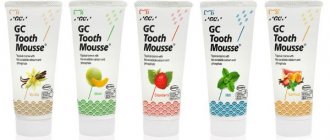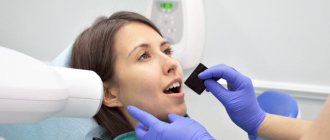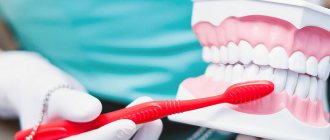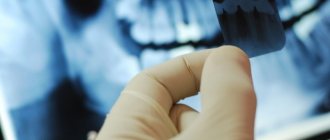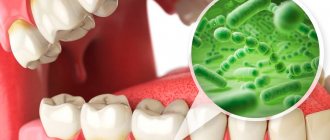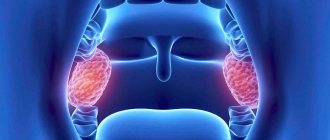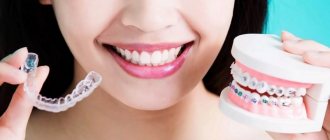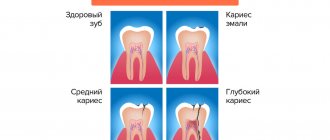Radiovisiographic examination is a method of computer radiographic examination in dentistry. Its goal is to obtain an image of the tooth and tissues around it with minimal radiation exposure. It has proven itself well in diagnosing hidden carious processes, inflammation of the pulp or periodontium, and identifying foreign objects in the tooth canal. Thanks to him, the dentist has the opportunity to control the quality and effectiveness of the treatment. During the procedure, a detector is inserted into the oral cavity, which is aimed at the area under study: its image is displayed on the monitor.
You can undergo radiovisiography in Moscow at the dental department of CELT. Our clinic has been operating in the capital's paid medical services market for almost three decades. We have a modern radiovisiograph, which allows us to accurately and quickly make diagnoses, identifying diseases in the early stages of their development. Our surgeons, orthodontists, therapists, and orthopedists have decades of experience in scientific and practical work. They constantly improve their professional knowledge and skills and use effective and gentle treatment methods. You can find out the price of the study by going to the “Services and Prices” tab. To avoid misunderstandings, check the numbers with the information line operators or at your doctor’s appointment.
Consultation with a dentist-therapist - 1,000 rubles.
Radiovisiographic examination - 370 rubles.
At CELT you can get advice from a dental specialist.
- The cost of a consultation with a dentist-therapist is 1,000
Make an appointment
Radiovisiography in dentistry
Without radiovisiographic examination, diagnostics in dentistry would be impossible. This is computer radiography, which replaced the outdated film radiography. Thanks to it, you can get a clear image in just a few seconds, while the patient’s radiation exposure will be minimal - ten times less than when using a film device.
A digital visiograph is equipment that should be in any modern dental clinic, since today it is the only method that fully complies with international standards. Its operation is based on the same principle as a standard device, but the signal is sent not to the film, but to the CCD sensor (or, as it is also called, the matrix). The latter has greater light sensitivity than conventional film, so minimal exposure to radiation is sufficient to obtain a clear image.
The visiograph sensor is connected to a converter, which reads its signals, transforming them into a digital image. The latter is sent to the monitor where the doctor can see it. The digital format also has many advantages: it does not take up much space on your hard drive, where it can be stored for a long time, it can be transferred to a USB drive or sent by email.
How profitable is this?
And now the main question is why buy it. This is where elementary arithmetic comes to the rescue. The average cost of one package of film (1 package – 50 pictures) is 1250 rubles. The average daily throughput of the X-ray room is 15 patients. Taking into account the defect rate of 1/5, this is 20 shots per day. It turns out that one package of film is enough for 2.5 days. 144 packages are needed per year with a total cost of 180,000 rubles. And this does not take into account chemical reagents. With the average cost of a photo for a client being 120 rubles, the revenue will be 864,000 rubles. Thus, the net profit will be 684,000 rubles per year.
Let's now look at the visiograph. Its average price on the Russian market (with a resource of 400,000 images) is 130,000 rubles. Of course, there are obvious benefits. Add to this the simplest maintenance (you will have to clean it with soapy water or isopropyl alcohol), and a rather long service life.
You can purchase a visiograph by following the link.
Indications and contraindications for dental radiovisiography
The study can be used for targeted study of dental units, as well as for identifying hidden carious processes and inflammation of surrounding structures.
Indications
- Diagnosis of caries, inflammatory processes of pulp and periodontium;
- Monitoring their treatment (quality of endodontic treatment, in particular, filling of canals, correct placement of pins, tightness of seal to the walls of the tooth);
- Preparation for surgery to increase bone tissue to determine the degree of its atrophy and the characteristics of the process;
- Suspicions of neoplasms in the thickness of the soft tissues of the oral cavity;
- Cystic formations and granulomas at the roots of teeth;
- Determining the location of fragments of broken dental instruments in the root canal;
- Traumatic damage to a tooth (dislocation, bruise, fracture);
- Control of the implant after installation;
- Before sealing the fissures of teeth in order to ensure the absence of caries.
Contraindications
Absolute contraindications:
- The patient has serious mental disorders;
- Pathologies of a neurological nature;
- Depressive states.
Due to the minimal level of radiation, radiovisiography of the maxillofacial area can be performed on a child, provided that he can sit still for several seconds.
If indicated, the study can be performed on women during pregnancy and lactation. It is optimal to do this in the second trimester, after warning the diagnostician about pregnancy. This is necessary so that she is put on a special apron, which provides additional protection from x-rays.
X-rays of teeth
What is a visiograph and how does it differ from an x-ray?
This is one of the most common questions, like what is the difference between a car and a traffic light. It seems that both concepts have some kind of connection, but it is quite difficult to compare them. Also here. A radiovisiograph is a system that receives x-ray radiation, transforms it into digital form and displays the image on a computer screen.
Roentgen (who was Wilhelm Conrad) was a German physicist who gained worldwide fame for his discovery of short-wavelength rays with enormous penetrating power. The physicist himself called these rays X-rays (in English today they are called exactly that - X-ray), but now we often call them X-rays, and in everyday life simply “X-rays”. The unit of radiation power was also called the x-ray. Now it is clear that a visiograph and an x-ray are completely different things. If you compare the visiograph with anything, it’s with x-ray film, which it is universally replacing from all areas of medicine.
X-ray of teeth
Is it true that a visiograph is safer than a regular film photograph?
When asked about such a comparison, they mean the radiation exposure that the patient receives when using different techniques. In this sense, indeed, a visionograph is better, since its sensor is much more sensitive compared to film. Therefore, to obtain a high-quality image using a visiograph, you need significantly less shutter speed. To take a picture on film, the shutter speed is 0.5-1.2 seconds. To obtain the same image using a visiograph sensor – 0.05-0.3 seconds, that is, 10 times less. As a result, the radiation exposure received by the patient when using a visiograph is reduced to an insignificant minimum.
How many pictures can you take at one time? And in general, isn’t it harmful that when treating a large number of teeth, you have to take a lot of X-rays?
This is the most pressing of questions. This is an echo of the Chernobyl tragedy and life safety lessons that emerge in memory. But in our society there is still a very strong phobia towards everything that is even remotely connected in our heads with radiation. Any extra photo often raises questions about radiation sickness, or “will I glow in the dark?” Therefore, we will try to explain in more detail here. First from a scientific point of view.
To measure the amount of radiant energy applied to living tissue, various units are used - joule per kilogram, gray, rem, sievert, etc. In medicine, X-ray procedures typically measure the dose received by the entire body during one procedure—the effective equivalent dose, measured in sieverts. According to SanPiN 2.6.1.8-38-2003, when carrying out preventive medical x-ray procedures and scientific research, this dose should not exceed 1000 μSv (microsievert) per year. Moreover, here we are talking specifically about preventive studies, and not about therapeutic ones, where this bar is much higher.
What is 1000 µSv? Is it a lot or a little?
Remembering the famous cartoon, the answer is simple - depending on what you measure it in. 1000 μSv is approximately:
- 500 targeted images (2-3 μSv) obtained using a radiovisiograph
- 100 of the same images, but using good X-ray film (10-15 µSv)
So, apparently, even if we take 1 picture on a visiograph every day for the whole year, and also a couple of 3D computed tomograms per year, and the same number of orthopantomograms, then even in this case we will not get out beyond the limits of safe permitted doses.
there is no need to be afraid of receiving a significant dose of radiation during dental procedures . Even if you want to go beyond the permissible values, it is unlikely to be possible. To be clear, here are the doses needed to cause any serious health effects:
- 750000 μSv - short-term minor change in blood composition
- 4,500,000 μSv - severe radiation sickness (50% of those exposed die)
All these figures are incomparable in their significance with the doses we receive in everyday life. So even if, for some reason, several pictures are taken at once in a row, and the day before you were already “exposed” by doing an orthopantomogram, you don’t need to panic and run to the store to buy a Geiger counter or search on the Internet for “the first symptoms of radiation sickness.” To calm yourself down, it’s better to “detoxify” with a glass of red wine. There will be no point in this, but the mood will immediately improve.
Let us clarify that, for example, with one-stage basal implantation, control targeted images are taken before and after installation of implants (when installing 1-3 implants). And also after final prosthetics (7-8 days).
Is it possible to do x-rays for pregnant women?
We will not remind you that before pregnancy it is better to take care of your health in advance, including “preparing” your own teeth at the dentist. In order not to run away later with acute pain and doubts whether this or that manipulation will harm the development of the fetus... Therefore, you should leave the lyrics and pay attention to the facts and common sense. Without phobias, prejudices, speculations and myths. So, is it possible to do x-rays for pregnant women?
Here's what they write to us about this in the documents (SanPiN 2.6.1.8-38-2003):
7.16. Pregnant women are prescribed for X-ray examination only according to clinical indications. Studies should, if possible, be carried out in the second half of pregnancy, except in cases where it is necessary to decide on termination of pregnancy or the need for emergency or emergency care. If pregnancy is suspected, the question of the admissibility and necessity of an x-ray examination is decided based on the assumption that there is a pregnancy...
7.18. X-ray examinations of pregnant women are carried out using all possible means and methods of protection so that the dose received by the fetus does not exceed 1 millisievert for two months of detected pregnancy. If the fetus receives a dose exceeding 100 mSv, the doctor is obliged to warn the patient about the possible consequences and recommend terminating the pregnancy.”
In general, the conclusion from these two main points is simple and clear. It’s definitely not worth taking pictures in the first half of pregnancy, but in the second half - 1 mSv for a visiograph - this is practically unlimited.
I would also like to add that one often encounters bellicose stubbornness: an X-ray at the dentist during pregnancy is an absolute evil. It’s better, they say, to screw up a tooth, to cure crooked canals... there are a lot of teeth, pregnancy is more important. Moreover, such sermons are given not only by lay patients who have little understanding of the essence of things, but also often by dentists themselves who have forgotten their school physics course.
To resolve this doubt, we must understand that sources of ionizing radiation are not only found in medical offices. And it doesn’t have to be near Chernobyl (and now Fukushima) to receive some doses from the environment. After all, every second we are influenced by both natural sources (sun, water, earth) and man-made ones. And the doses received from them are much greater than those received from an x-ray of a tooth.
For clarity, we can give one simple example. As you know from a school physics course, the sun emits electromagnetic energy in a wide range, not only in infrared (heat), visible (light), ultraviolet (tan), but also in x-rays and gamma radiation. Moreover, the higher the earth's surface, the more rarefied the atmosphere and, therefore, the weaker the protection from sufficiently strong radiation from the sun.
After all, while “fighting” radiation at the dentist, the same people often calmly fly south to bask in the sun and eat fresh fruit. Moreover, during a 2-3 hour flight in a “healthy” climate, a person receives 20-30 μSv, i.e. the equivalent of approximately 10-15 images on a visiograph. In addition, 1.5-2 hours in front of a cathode ray monitor or TV gives the same dose as 1 picture... How many pregnant women sitting at home, watching TV shows and surfing the Internet, think about how many pictures they “took”? while watching another program, and then discussing it with friends on the forum and social networks? Almost no one, because people do not associate all this with ionizing radiation, unlike a picture in a doctor’s office.
And yet, dear expectant mothers, prepare for pregnancy in advance. For many people, visiting the dentist still remains stressful. And it’s not so much that anesthesia or x-rays can be harmful during this period, but what is important is your peace of mind and the absence of unnecessary worries (of which many already have more than enough during this period). You can study more information on this topic in our article “Can teeth be treated during pregnancy.”
What is the best protection to use if you need to take a photo while pregnant?
The number of aprons does not matter. In contact radiography, the apron essentially protects not from direct radiation, but from secondary, that is, reflected. For X-rays, the human body is an optical medium, like a glass cube for a flashlight beam. Point the beam of a flashlight at one of the faces of a large glass cube and, regardless of the thickness and direction of the beam, the entire cube will be illuminated. It’s the same with a person - you can swaddle him completely in lead and shine only on his head - at least a little, but it will reach every heel. So even under two aprons with a good lead equivalent, a pregnant woman will, at most, simply have a harder time breathing.
Is it possible to do x-rays for breastfeeding mothers? And if possible, then what about feeding the child after the procedure?
Can. X-rays are not the same as radioactive waste. By itself, it does not accumulate in the biological environment. If you irradiate a loaf of bread with a lethal dose, it will not mutate, get radiation sickness, or begin to “foul.”
X-rays differ from light rays only in wavelength and have a direct damaging effect only under certain conditions. If you shine a flashlight into a bucket of water and turn off the flashlight, the light won't stay in the bucket, right? The same is true in a protein-fat solution, which is what many biological fluids are (including breast milk) - the radiation passes right through. So, with such a load that is necessary to work with a visiograph, it is unlikely that anything will happen to the milk itself.
As a last resort, to reassure yourself, you can skip one regular feeding. Another thing is that the breast tissue itself during lactation is, of course, more susceptible to the harmful effects of radiation. But, again, we are talking about doses much more powerful than is necessary for digital radiography (of course, subject to all protective measures and without “shooting” 20 times anywhere).
Advantages of radiovisiographic examination
This research method is considered the best option both for a dental office and for a large clinic in which several specialists work at once. Its advantages:
- Efficiency and the ability to receive an image instantly, without waiting;
- High clarity and information content of the image, in which you can see the condition of the teeth, surrounding tissues, and implants;
- Minimum number of restrictions (possibility of use for children and pregnant patients);
- Convenient digital format, the ability to print the image on paper.
Do not forget that visiography is an environmentally friendly and harmless research method. It does not require the use of film or aggressive chemicals for development. The radiation dose received during filming of the lower jaw is 2 microsieverts, the upper – 5 microsieverts. For comparison, when using a film apparatus, it is equal to 30 and 80 microsieverts, respectively.
The resulting images clearly show:
- Carious lesions, cystic formations, granulomas and inflammatory processes. They are transmitted in black;
- Fillings, inlays, pins, dentures – white areas;
- Connective and bone tissue are gray areas.
Flaws
Radiovisiography has only one disadvantage - the spatial resolution is one and a half to two times lower than that of film. Because of this, the sensor does not clearly convey the difference between structures that differ significantly in density. However, this shortcoming is compensated by the ability to correct the brightness and contrast of a digital image.
Shot on film
Reviews about our dental therapists
I would like to express my gratitude to the dentist Elena Nikolaevna Kiseleva and her assistant Svetlana - they are real specialists and at the same time sensitive, not burnt out by years of practice.
Thanks to them, I have been coming back here for many years. Thanks to the management for such doctors! Read full review Svetlana Nikolaevna
13.08.2021
I am very grateful to Evgeniy Borisovich Antiukhin for removing my three eights. Especially considering that the lower tooth was not the simplest (it was located in an embrace with a nerve). The removal took place in 2 stages, one tooth under local anesthesia, two under general anesthesia. I had no idea that wisdom teeth could be... Read full review
Sofia
28.12.2020
How is dental radiovisiography performed?
The procedure is very simple and absolutely painless and does not require preparation. The patient is asked to take a sitting position on a chair near the device, after which a sensor is applied to the area under study and the patient is asked to gently bite the sensor with his teeth. This prevents its displacement. After this, the tube of the device is directed to a certain area of the jaw. The diagnostician starts it, and X-rays begin to illuminate the tissue. The signals are captured by the sensor, then sent to the converter and (already in the form of a graphic image) to the monitor.
Difference between radiovisiography, OPTG and computed tomography
Unlike visiography, OPTG - orthopantogram (or, as it is also called, panoramic image) covers not one or three teeth, but the entire dental system. An orthopantomograph is used to obtain images. Most often, such diagnostics are prescribed to young patients in order to assess the condition of the rudiments of permanent teeth. As for computed tomography, it provides not a two-dimensional, but a three-dimensional image of the patients’ jaw system. For this reason, it is carried out before implantation and bone augmentation operations that precede it, in order to plan them in detail.
You can make an appointment with dentists and undergo radiovisiography at CELT online or by contacting our information line operators: +7 (495) 788‑33‑88.
Make an appointment through the application or by calling +7 +7 We work every day:
- Monday—Friday: 8.00—20.00
- Saturday: 8.00–18.00
- Sunday is a day off
The nearest metro and MCC stations to the clinic:
- Highway of Enthusiasts or Perovo
- Partisan
- Enthusiast Highway
Driving directions
Indications for radiography using a visiograph
Dental X-rays are taken so that the dentist can analyze the condition of both individual teeth and the patient’s jaws. A visiograph takes control and intermediate images during therapy and filling of dental canals. Endodontic treatment is not carried out without radiographic examination.
An intermediate series of photographs is needed to measure the working length of the dental canal and determine its patency. A control x-ray is indicated after completion of therapy to monitor filled roots. Digital visiography will allow you to avoid serious complications, monitor the stages of dental canal filling and adjust the dentist’s work.
